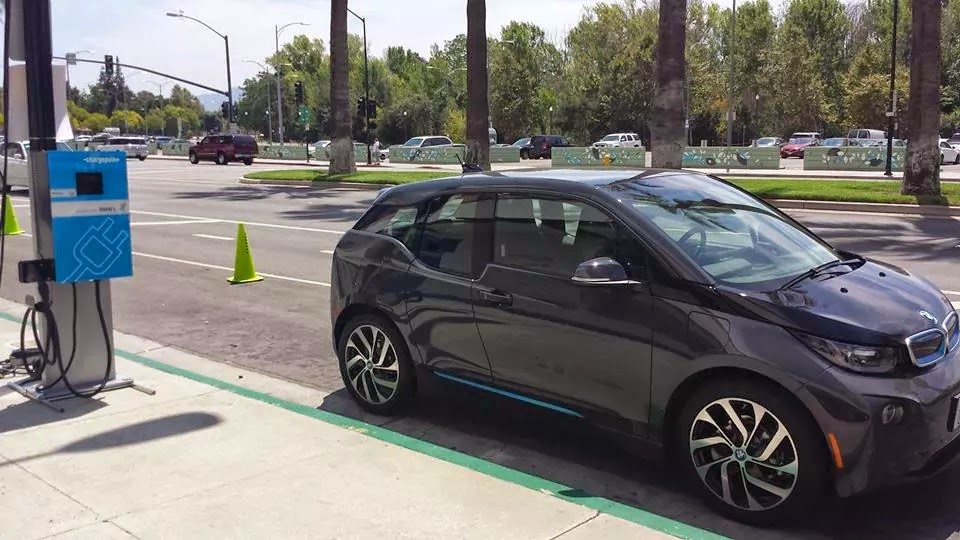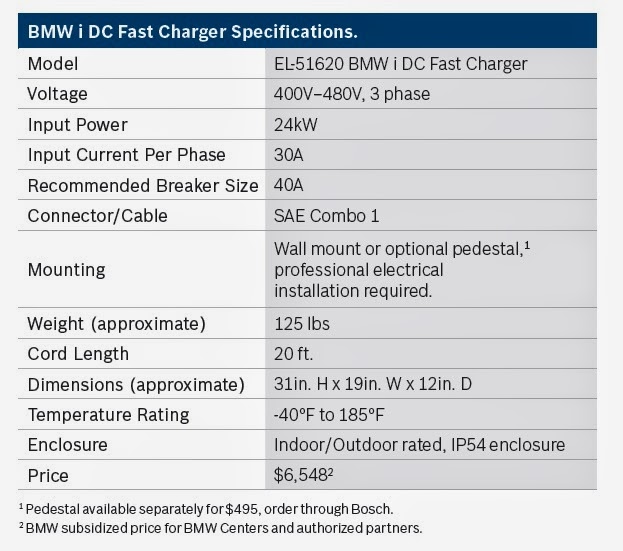 |
| The very first public display of the new BMW i DC quick charger |
This is a huge step forward for BMW i and the EV movement in general. I have consistently contended that the mass adoption of electric vehicles will hinge on the deployment of rapid charging. Even though the majority of charging will be at a slower rate and overnight, for EVs to really be taken seriously by the masses they need to be capable of refueling in less than an hour while making longer journeys. Tesla and Nissan have already demonstrated that they understand this and have made significant investments in DC quick charge infrastructure, and today's announcement from BMW is proof that BMW also realizes this and appears ready and willing to jump into the DC quick charge game.
 |
| The new BMW i 24kW DC quick charger |
So if these DC quick chargers only supply 24 kW's that must mean they charge the cars much slower than a conventional 50kW DC quick charger, right? Wrong. This is what I meant about these being tailored for the i3. The i3's relatively small battery can't really utilize a higher rate than 24kW effectively. All DC Quick chargers taper off to a lower charge rate once they get close to fully charging the battery to prevent overcharging and damaging the cells. The i3 only has a usable battery capacity of 18.8kW's so on a 50kW quick charger it only will charge at the full rate for about 10 minutes before it starts ramping down to a lower charge rate. In fact, BMW claims the i3 will charge to 80% in about 25 minutes on a 50kW DC quick charger. On this new 24kW unit, it only takes about 5 minutes longer, charging to 80% SOC in 30 minutes. So for only an extra 5 minute penalty, you get:
1) A low-cost solution for DCQC. BMW will sell the unit to their partners for only $6,548 which is less than half as expensive as the least expensive 50kW CCS DC quick charger made by ABB. "Partners" include BMW dealerships, utilities and municipalities that want to provide this service. BMW hasn't decided on a regular retail cost for the units but they are willing to discuss it with interested parties.
2) The unit is small, measuring 31"(H) x 19" (W) x 12"(D) and only weighs about 125 lbs. It can even be pedestal or wall mounted, unlike any other DCQC on the market.
3) The sites won't have to pay the excessive demand charges for electricity. Instead it will be the regular electric rate, allowing for a reasonable cost to be assessed for use of the charger.
Even with all this great news, you'll notice the title reads that this is a "potential" game changer. As good as these units sound, they won't do any good if they aren't installed. It's already been announced that in California the NRG eVgo DC Fast Charging network will deploy a minimum of 100 BMW i3 compatible DC Fast Chargers, but what about the rest of the country? Will BMW step up and prove they are "all in" like Nissan and Tesla have and assist (yes that means subsidize) the deployment of these quick charge stations in other markets? Only time will tell, but I have to say I like what I'm seeing so far. Let's keep the ball rolling BMW.
 |
| Specifications for the new DCQC unit |
Below is the full press release from BMW:
San Jose, CA/Woodcliff Lake, NJ � July 28, 2014� At Plug-In 2014, a conference dedicated to discussing key issues for the long-term success of electric vehicles, BMW of North America launched its BMW i DC Fast Chargers which can charge the BMW i3 all-electric vehicle�s battery up to 80 percent in 30 minutes. A joint development between BMW and Bosch Automotive Service Solutions, BMW i DC Fast Chargers will change the face of public charging as the first compact and affordable DC Combo fast charger. The first BMW i DC Fast Charger will be on display at Plug-In 2014 on July 28 at the San Jose Convention Center. BMW also announced its new ChargeNow DC Fast program in cooperation with NRG eVgo, in which BMW i3 drivers in California can enjoy no cost unlimited 30 minute DC fast charging, at NRG eVgo Freedom Station� sites equipped with DC Combo Fast Charging, through 2015.
Introducing the BMW i DC Fast Charger
Conventional DC fast chargers are about the size of a standard refrigerator, cost tens of thousands of dollars and require a significant amount of electricity. Half the size of a traditional electric vehicle DC charger � measuring 31�H x 19�W x 12�D and weighing approximately 100 pounds � BMW i DC Fast Chargers can be mounted on a wall, a first for electric vehicle DC fast chargers. In addition, BMW i DC Fast Chargers will be priced significantly less than other DC Combo chargers in the market at $6,548 for authorized BMW partners.
�This is a milestone in the development of the DC fast charging infrastructure. With more than five years of real world experience, we understand that a robust network of publicly available DC Combo Fast Chargers is a key part of the mobility of tomorrow,� said Robert Healey, EV Infrastructure Manager, at BMW of North America. �BMW is offering the BMW i DC Fast Charger at an appealing price point, and more manageable size, to make the convenience of DC fast charging more accessible for BMW i3 owners.�
The 24 kW DC Fast Charger feeds the current directly to the vehicle�s battery, resulting in a more efficient and faster charge. BMW i DC Fast Chargers use the SAE Combo 1 connector, the North American automotive industry standard for fast charging; feature a rugged aluminum IP54 enclosure; meet NEMA 3 requirements; and are designed to perform in extreme weather conditions, from -40�F to 185�F. Additionally, the BMW i DC Fast Charger is ChargePoint network-enabled, allowing electric vehicle drivers with the SAE Combo 1 inlet to access the BMW i DC Fast Charger using a ChargePoint or ChargeNow card. Major automakers including BMW, GM, Ford, Chrysler, Daimler, Volkswagen, Audi and Porsche have committed to adopting the SAE Combo 1 inlet for DC charging. The BMW i DC Fast Chargers will be available for BMW i Centers across the U.S. beginning in August.
Introducing ChargeNow DC Fast for BMW i3 Drivers
In keeping with its holistic approach to making DC fast charging more accessible and, in turn, increasing the adoption of electric vehicles, BMW, in cooperation with NRG eVgo, will offer no cost charging to BMW i3 drivers at participating eVgo Freedom Station sites equipped with DC Combo Fast Charging in California through 2015.
Using their ChargeNow cards, BMW i3 drivers will have access to unlimited 30-minute DC fast charging sessions with the ChargeNow DC Fast program. BMW i3 owners can sign up easily for ChargeNow DC Fast at chargenow.com/us. In order to receive the full benefits of the program, BMW i3 drivers must use the ChargeNow card, provided with their BMW i3, to charge the vehicle at least once by December 31, 2014, at a participating eVgo Freedom Station. By doing so, BMW i3 drivers will enjoy continued access to no cost DC charging sessions through the end of 2015. Eligible BMW i3 vehicles must be equipped with the DC Fast Charging option (SAE).
�We�re confident the rapidly-expanding NRG eVgo DC Fast Charging network will provide significant benefits to BMW i3 drivers in California,� continued Mr. Healey. �With the cooperation between ChargePoint and NRG eVgo, ChargeNow DC Fast brings us closer to the reality of one card, one account public charging network interoperability.� eVgo will deploy a minimum of 100 BMW i3 compatible DC Fast Chargers across California to support the ChargeNow DC Fast Program.
�This is a milestone in the development of the DC fast charging infrastructure. With more than five years of real world experience, we understand that a robust network of publicly available DC Combo Fast Chargers is a key part of the mobility of tomorrow,� said Robert Healey, EV Infrastructure Manager, at BMW of North America. �BMW is offering the BMW i DC Fast Charger at an appealing price point, and more manageable size, to make the convenience of DC fast charging more accessible for BMW i3 owners.� - See more at: http://www.longtailpipe.com/2014/07/bmw-shows-smallest-and-lowest-cost-dc.html?utm_source=dlvr.it&utm_medium=facebook#sthash.B9P4jL3V.dpuf
�This is a milestone in the development of the DC fast charging infrastructure. With more than five years of real world experience, we understand that a robust network of publicly available DC Combo Fast Chargers is a key part of the mobility of tomorrow,� said Robert Healey, EV Infrastructure Manager, at BMW of North America. �BMW is offering the BMW i DC Fast Charger at an appealing price point, and more manageable size, to make the convenience of DC fast charging more accessible for BMW i3 owners.� - See more at: http://www.longtailpipe.com/2014/07/bmw-shows-smallest-and-lowest-cost-dc.html?utm_source=dlvr.it&utm_medium=facebook#sthash.B9P4jL3V.dpuf























